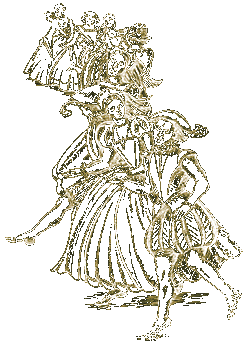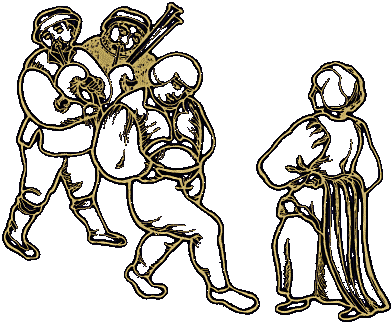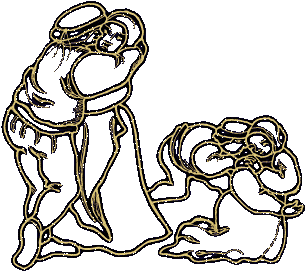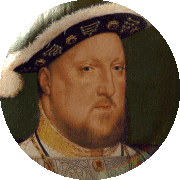Dance
Dancing in the 16th and 17th centuries was an elegant form of exercise and an expected social skill for the nobility. Courtiers showed loyalty to the king with elaborate displays of dance, costume and music.

There were two main contrasting dances of the period. First the Pavane, a dance of the court, used on state occasions. It was a solemn, couples gliding, ceremonial dance, which came from Italy around 1508. With the lady holding the man's hand, the couple dance with ceremonial dignity using a strut-like motion resembling a peacock. The dance is very simple, with two single steps and one double step, moving forwards and backwards in 4/4 time.
The second dance is a lively and popular country chain dance, where everyone holds hands and follows the leader. It is called the Farandole. According to tradition it was taken to Marseilles from Ancient Greece by Phoenician sailors in the 9th century. It has a very quick and rhythmical movement. The importance of the dance is in the figures such as The Ribbon, The Snail and Arches.

Dance at the Tudor Court
"This wondrous miracle did Love devise
For dancing is love's proper exercise"
The 16th century is renowned as "The Golden Age" when the great "Renaissance" of the Arts was said to have flourished in Europe. With the arrival of the printing press came a wide ranging interchanging of ideas and fashions throughout the European courts- notably Italy, Spain, France and of course England.
In the 16th century, ladies and gentlemen of noble birth were taught from an early age the good manners and graces to survive in the hierarchical world of the court.
Dancing was one of the most important means of expressing these "princely virtues" and played an incredibly important part in 16th court life. Dancing was an art which was understood on different levels. It was not only a means of recreation but an illustration in miniature of the workings of the world, dancers being compared to celestial bodies moving in harmony along their ordered paths through the universe:

In masques and other court entertainments, dance was used to great political advantage, the symbol of each movement and figure working to reflect the glory and prestige of the monarch. A spectacle of this kind would include a huge cast with sumptuous costumes, lavish sets and scenery. A whole series of tableau, rather like modern carnival floats would be presented from which talented courtiers could perform songs, long flattering speeches to the host and complicated pattern dances often ending in a representation of the initials of the monarch's name.
(The nearest modern equivalent is the ceremonial display mounted by the host country, for the opening and closing of the Olympic Games.)
After these formal entertainments, everyone could join in the social dancing. This would begin with a slow, stately dance such as a Measure or a Pavan. Then came the Revels, where everyone ate too much, drank too much and danced the livelier dances such as the Almains, Corantos, Country Dances or the famous La Volta. This was said to be one of Queen Elizabeth's favourites. It was thought to be shocking because of the intimate manner in which the man grasped the lady, throwing her into the air in such a way that she might display a "bare thigh".
Dancing was considered as one of the necessary manly accomplishments along with swordsmanship and riding. It was the perfect opportunity for a man to show off his strength, stamina, agility, grace and skilful footwork. It also provided a rare opportunity for gentlemen to lure their partner away from their chaperones! When dancing the men were permitted to:
"Kiss their mistresses in order that they may touch and savour one another, thus to ascertain if they are shapely or emit a bad odour as of bad meat."
Ladies were expected to be modest, charming, graceful, and to present a pleasing, affable and at all times cheerful appearance - even if they were never invited to dance.

Dance amongst the common folk.
While the Courts of Europe busied themselves with politics, etiquette and fashion, village life consisted mainly of hard work. It is easy to understand therefore, the importance of dancing and revelry during country holidays and why the least excuse for festivity would bring villages trouping out onto the green to make merry, quaff ale and abandon their cares in the dance. Most towns and villages had some sort of band or groups of musicians who would provide music on such occasions. Since they relied on memory and not printed music, their repertoire was probably fairly limited.
The general atmosphere of debauchery and gay abandon can be seen in the paintings of Peter Breughel the Elder.
Breughel's villagers demonstrate how dangerous these dances might be with the jostling, tugging and increasing momentum. Those unfortunate enough to be on the end of the line could find themselves being hurled through the air, the women's skirts flying over their heads.

Perhaps it is not too difficult to understand why the English corrupted the French word 'Branle' (to sway) to the more illuminating 'brawl'.
Dance in Stuart England
Although the people of England were sad to lose their great 'Prince' Queen Elizabeth, they welcomed the security of a lawful successor after so many years of uncertainty about an heir to the throne. King James indeed was to reign for almost as long as Elizabeth herself.
James was rather unprepossessing in appearance - certainly not the personification of the Renaissance Courtier to look at! His manners too, would have caused raised eyebrows.
"He was very intemperate in his drinking: and he would make a great deal too bold with God in his passion, both in cursing and swearing, verging on blasphemy."
Dancing was therefore a courtly practice which served only to emphasise the fact that he could never match the physical prowess of his parents. However, James enjoyed being a patron of this art - at any cost! He once commissioned four Negro dancers to dance aesthetically in the snow during his wedding celebrations. Tragically, they subsequently died of pneumonia.
James had a genuine love of learning, and he was quick to grasp the importance of display and pageantry to enhance his image. His court witnessed the spectacular masques of Ben Johnson, performed with the fantastic sets and costumes designed by Inigo Jones. Whitehall Banqueting Hall itself was a shrine to the king's glory.
The Queen, Ann of Denmark, was also a keen dancer and appeared in many of the masques herself. She made good use of the old Queen's immense wardrobe in decking herself out in suitable costumes.
Taken from "The Art that all other Arts do Approve", teaching aspects of Tudor and Stuart history through Early Dance and its music.
By kind permission of Warwickshire County Council Education Department.
Curriculum links:
- PE: Dance activities
- HISTORY: Lives of the rich and poor; entertainment in 1605.

